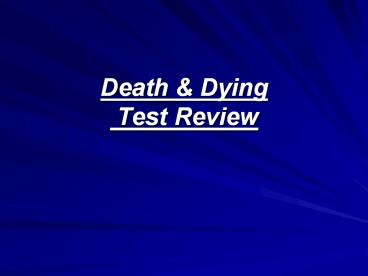Death PowerPoint PPT Presentation
1 / 19
Title: Death
1
Death Dying Test Review
2
Why we fear death?
- Most fear is of the unknown.
- Death is the greatest unknown.
- Hiding from it/never talking about it will make
the fear worse. - Deal with fear by making it known
3
Fears associated with death Know 2 in each.
- 1. Loss of life
- Leaving loved ones
- Unfinished business
- Giving up our possessions
- 2. Process of dying
- Losing control
- Indignity
- Pain or Discomfort
- 3. Death itself -- Afterlife
- Unknown
- Possible punishment
- Possible annihilation
- 4. The Dead
- Ghosts
- Evil spirits
4
Why North Americans can more easily deny death
(3)
- No war on our own soil.
- No public executions.
- Longer life-span. (makes us further removed from
death). - Removed from mainstream living (nursing homes,
hospitals, etc.) - Society glorifies youth
5
Grief Work
- Grief Work is necessary because part of us has
been invested in another and we must retrieve
that part of us that was lost. (rebuilding) - Grief Work involves
- Facing
- Breaking
- Replacing
- You are not replacing the PERSON, just the
activities and the human (earthly) interaction.
6
Preparing for Grief
- Education (Example this course!)
- Philosophy of Life
- Must be broad enough to include a
philosophy of death. - Build sound community practice\
- Wakes, funerals, etc.
7
Emotions Associated with Grief (3) but be able to
explain each
- Fear of being alone
- Guilt
- Neurotic Guilt - Guilt feelings out of
proportion to the cause - Anger
- a. Directed Outward (anger at others)
- b. Directed Inward (depression angry at self)
- At God
- At the person
- Emptiness
- Frustration Helplessness
- WHO DO WE GRIEVE FOR? OURSELVES!
8
Abnormal Grief
- Experiencing these mood changes and emotions
(anger, fear, guilt, etc.) after approximately
one month. - Widows and widowers may take longer
9
True False of Suicide Myth or Truth?
- Teenage suicide is preventable. True
- Suicide is the 3rd leading cause of death for age
15-24 and number is increasing dramatically. True - Young people commit suicide at a rate of one
every hour and 40 minutes in the U.S. True - Teenagers talk about suicide to get attention.
True BUT . - All teenagers who commit suicide are depressed.
True (but all depressed teens arent suicidal). - Suicidal people really want to die and you cant
stop them. False
- Talking about suicide will cause someone to try
it. False - If a person wants to kill themselves, we have no
right to stop them. False - Once suicidal, you are suicidal forever. False
- Suicidal thoughts are a sign that the person is
crazy. False - The suicide rate is highest among the elderly.
True - The most common time for suicide is mid-winter.
False
10
Mortido
- Freud says that all people have a death wish or
mortido - Mortido can show itself in (3)
- Smoking
- Drinking
- Drug use
- Sexual promiscuity
- Risky behavior
- Etc.
11
Émile Durkheim French Sociologist
- 4 Types of Suicide Define, not list
- Egoistic ? Person feels detached from the world
alone. Nobody understands or cares. - Altruistic ? Person feels that the good of
society is the greater good, over their own needs
even over their life -- suicide for a cause - Anomic ? Caused BY a breakdown of society. Person
feels unable to live in the society needs can
never be met. - Fatalistic ? Living under an oppressive
government, living in prison, etc. Person feels
it is better to die.
12
- Suicide rate is highest among the elderly They
are at the bottom of the list for suicide threats
and attempts HOWEVER at the TOP of the list for
completed suicides. - Most common times for suicide
- Christmas
- Springtime
- Because of the CONTRAST between how the person
feels and the outside world.
13
Warning Signs of Suicide Know meaning of each and
be able to list 3
- Suicide Attempt
- Suicide Threat
- Situational Hint
- Family Hint
- Emotional Hint
- Mental Illness
- Other Hints (3) Giving away possessions,
suddenly happy after long depression, gathering
weapons, preoccupied with death, making final
arrangements .etc
14
How can we help someone in this situation? Know 3
but the MEANING of all.
- Be aware of the warning signs
- Maintain a relationship based on total acceptance
of the person - Listen let them vent
- Dont moralize or lecture them
- ?
15
- Identify the source of the distress. Just like
talking to terminally ill patients let them
express feelings freely. - Look for problem-solving resources that the
person may have i.e. How have they solved
problems before? - Identify the persons values Find what is
important to them (family, friends, etc.) and
capitalize on that! - Dont try to handle the problem alone!
- Remove from the premises any weapons or
potentially dangerous medications
16
Afterlife after suicide
- We cant judge.
- God calls ALL of us.
- Free will! The consequences are ours.
- Analogy of Jumping and Living Karma
- Suicide is a permanent solution to a temporary
problem.
17
Elisabeth Kübler-Ross
- Pioneer in bringing the discussion of death and
dying out into the mainstream. - In the late 1960s
- Originated the 5 Stages of the Dying Process
18
5 Stages of Dying
- Denial
- Anger
- Bargaining
- Depression
- Acceptance
- Know how each stage works.
- Know other areas where these stages might apply.
19
Dealing With the Dying
- Be able to discuss 7 of the 14 points given in
class.

